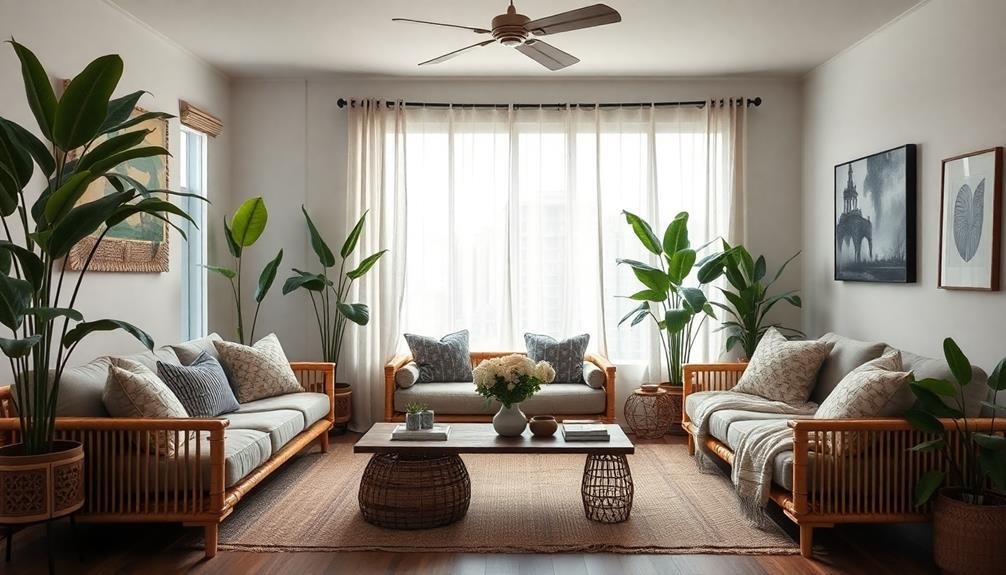In 2025, you'll want to embrace sustainable decor trends that prioritize eco-friendliness. Start with reclaimed and upcycled materials, which not only reduce waste but also add unique character to your space. Biophilic design will bring nature indoors with plants and natural light, enhancing your well-being. Eco-friendly fabrics like organic cotton and low-VOC paints contribute to a healthier environment. Incorporate energy-efficient technologies, such as smart lighting and thermostats, for convenience and savings. Prioritizing local sourcing supports community artisans and reduces transportation emissions. These trends not only beautify your home but also foster a sustainable future, and more insights await you.
Reclaimed Materials in Design
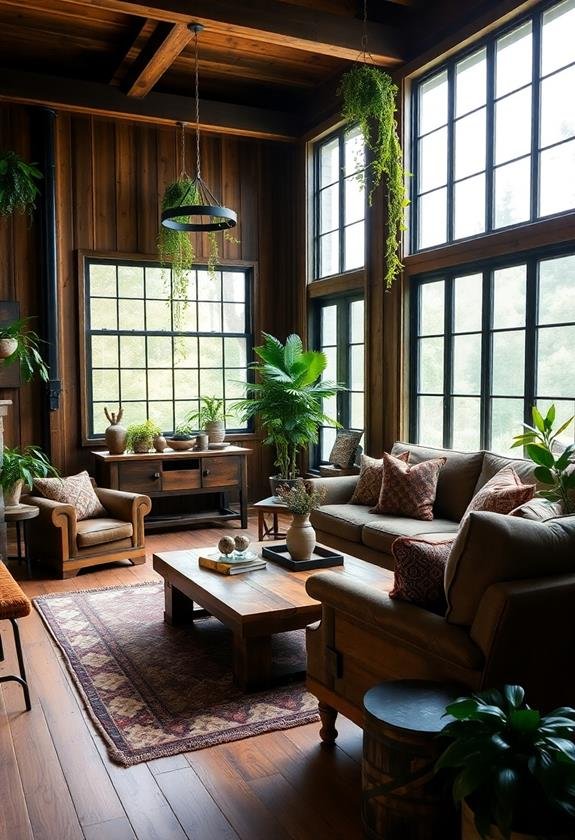
Reclaimed materials in design are making a significant comeback as more people look to incorporate sustainable practices into their homes. You might not realize it, but using reclaimed wood, metal, or even textiles can add unique character to your space while minimizing environmental impact. For instance, imagine a coffee table crafted from salvaged barn wood; it tells a story and enhances the rustic charm of your living room. Additionally, many eco-friendly furniture brands are now offering innovative designs that utilize these materials, allowing consumers to choose stylish yet sustainable options for their homes. This trend aligns perfectly with the growing interest in discovering sustainable furniture.
Incorporating these materials isn't just eco-friendly; it also promotes creativity. You can mix styles and textures that wouldn't typically pair well, creating a personalized aesthetic that reflects your taste. One popular trend is using reclaimed wood beams for exposed ceiling designs, instantly adding warmth and a sense of history to the room.
Moreover, you'll find that reclaimed materials often come at a lower cost compared to new products, making them an economical option for budget-conscious homeowners. Local salvage yards or online marketplaces provide plenty of options to explore. As you embrace reclaimed materials, you'll contribute to reducing waste and supporting sustainable practices, all while enjoying a beautifully designed space that's truly one-of-a-kind.
Biophilic Design Elements
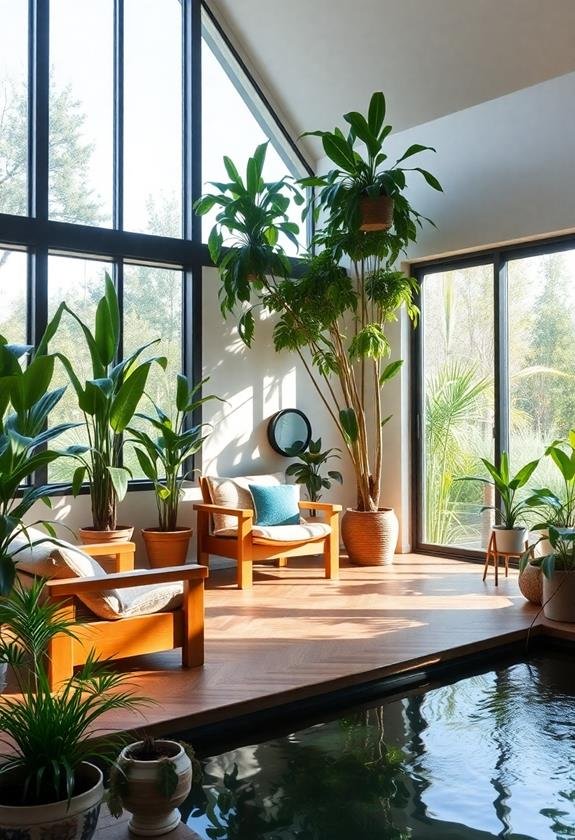
Incorporating biophilic design elements into your home can greatly enhance your space by connecting you with nature. This design philosophy emphasizes the human connection to the natural world, promoting well-being and serenity. To get started, consider adding indoor plants. They not only purify the air but also create a calming atmosphere. You might choose low-maintenance varieties, like snake plants or pothos, which thrive with minimal care. Additionally, you can opt for artificial indoor plants that require no maintenance, offering a hassle-free way to incorporate greenery into your decor.
Another way to bring biophilic design into your home is through natural light. Large windows or strategically placed mirrors can help brighten your space, making it feel more open and inviting. Additionally, using natural materials like wood, stone, and clay in your decor fosters a sense of warmth and connection to the environment.
Incorporating water features, such as a small indoor fountain, can also evoke the soothing sounds of nature, enhancing your home's ambiance. Finally, consider using nature-inspired artwork or colors that reflect the outdoors, like greens and browns, to further integrate this design style. By blending these elements into your decor, you'll create a harmonious living space that nurtures both your mind and body.
Eco-Friendly Fabrics
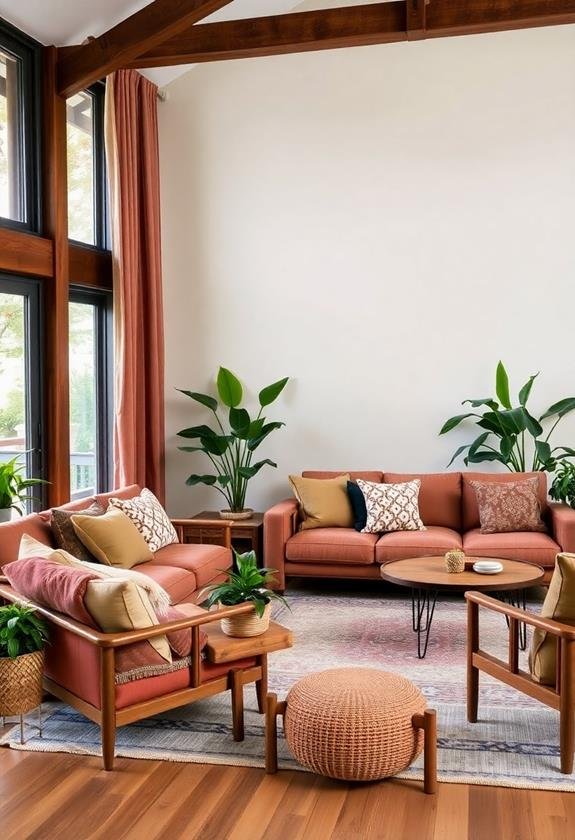
When it comes to creating a sustainable home, choosing eco-friendly fabrics is a crucial step. These materials not only contribute to a healthier planet but also enhance the aesthetics of your living space. Look for fabrics made from organic cotton, linen, or hemp, as they're grown without harmful pesticides or synthetic fertilizers. These options reduce your exposure to toxic chemicals and support sustainable farming practices. Additionally, incorporating bamboo textiles can elevate your space with their silky feel and durability, making them an excellent choice for eco-conscious consumers seeking bamboo decor options.
Recycled materials, like polyester made from plastic bottles, are another fantastic choice. By opting for these textiles, you help divert waste from landfills and reduce the need for virgin resources. Additionally, consider natural dyes and finishes, which minimize environmental impact while adding unique character to your decor.
When selecting eco-friendly fabrics, it's important to check certifications, such as Global Organic Textile Standard (GOTS) or OEKO-TEX, to verify the materials meet strict environmental and social criteria. You might also explore innovative fabrics like Tencel, derived from sustainably sourced wood pulp, which boasts a soft feel and excellent moisture-wicking properties.
Energy-Efficient Lighting
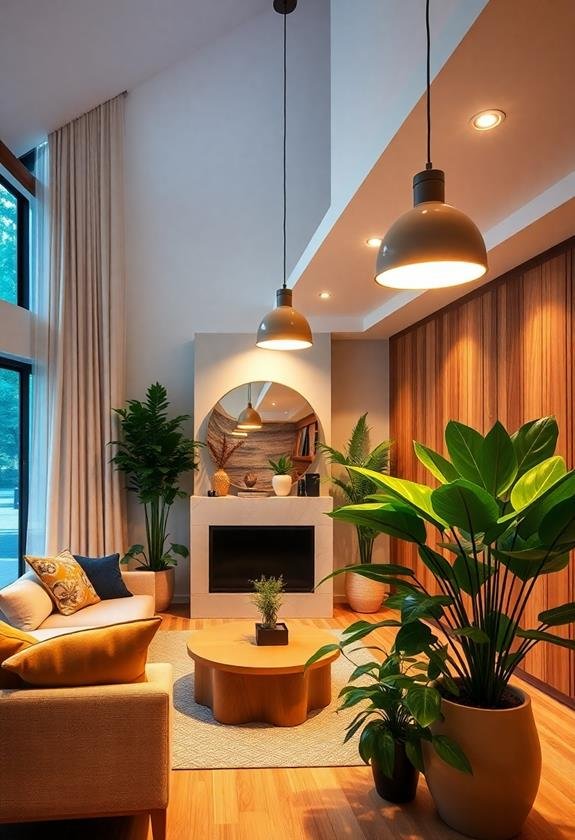
Brightening up your home with energy-efficient lighting is a smart move for both your wallet and the environment. These innovative lighting options, like LED bulbs, consume considerably less energy compared to traditional incandescent bulbs, often lasting up to 25 times longer. Imagine reducing your electricity bills while also cutting down on your carbon footprint—it's a win-win!
When you switch to energy-efficient lighting, you'll notice an immediate improvement in your space's ambiance. These bulbs come in various color temperatures, allowing you to create the perfect atmosphere, whether you prefer a warm, cozy glow in your living room or bright, crisp light in your kitchen. Plus, many energy-efficient fixtures are designed with aesthetics in mind, seamlessly blending into your decor.
As you commence on your journey toward a more sustainable home, consider smart lighting options. Smart bulbs can be controlled via smartphone apps, enabling you to adjust brightness and schedule when lights turn on or off, optimizing energy use. By making these simple changes, you'll not only enhance your home's look but also contribute positively to the planet's health. Embrace energy-efficient lighting and watch your space transform!
Upcycled Furniture Trends

Upcycled furniture trends are revolutionizing how you can furnish your home while being eco-conscious. Instead of buying new pieces that contribute to waste, you can breathe new life into old furniture. This movement emphasizes creativity, allowing you to transform items like wooden pallets into chic coffee tables or vintage suitcases into stylish storage solutions.
As you explore upcycled options, think about the stories behind each piece. A refurbished chair may have belonged to a family member, adding sentimental value to your space. Many designers are now focusing on sourcing materials from thrift stores or flea markets, making it easier than ever for you to find unique, one-of-a-kind items.
Moreover, embracing upcycled furniture isn't just beneficial for the environment; it can also save you money. By reimagining what you already have or selecting pre-loved pieces, you can create a distinct style that reflects your personality. Look for local workshops or online tutorials to spark your creativity, and you'll soon discover that upcycled furniture isn't just a trend, it's a sustainable lifestyle choice that allows you to express your individuality while caring for the planet.
Minimalist Aesthetics

In recent years, minimalist aesthetics have gained traction as a powerful way to create peaceful and clutter-free spaces. This design philosophy emphasizes simplicity, focusing on essential elements and eliminating distractions. You'll find that minimalist spaces often feature neutral color palettes, clean lines, and functional furniture, which all contribute to an atmosphere of calm and clarity.
To embrace minimalist aesthetics, start by decluttering your environment. Remove unnecessary items and keep only what you truly need or love. This approach not only enhances your space visually but also promotes emotional well-being by reducing stress and anxiety.
Consider incorporating natural materials like wood and stone, as they not only add warmth but also align with sustainable practices. When selecting decor, opt for a few statement pieces rather than an overload of decorations; this choice allows you to showcase unique items without overwhelming the senses.
Ultimately, minimalist aesthetics invite you to create spaces that reflect your values and lifestyle. By prioritizing quality over quantity, you can design an environment that encourages mindfulness, creativity, and peace, making it a perfect fit for the sustainable decor trends of 2025.
Smart Home Technology
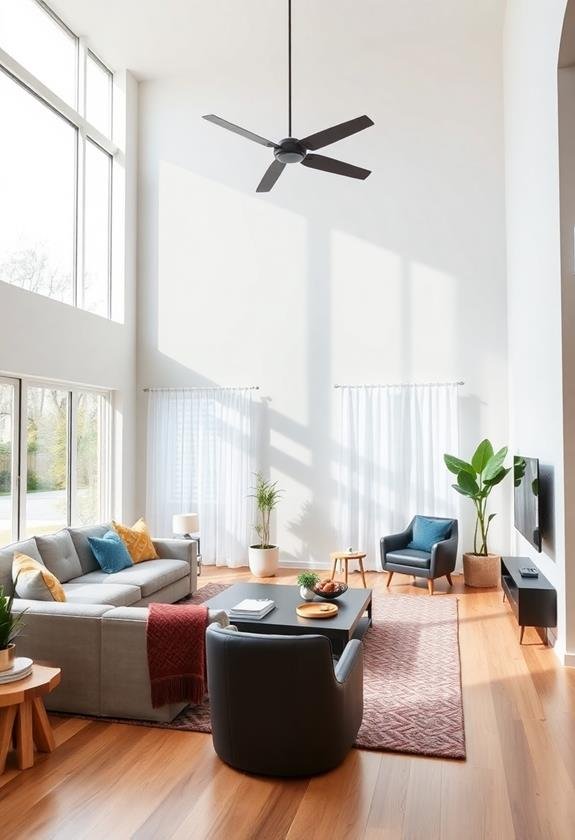
Efficiency and convenience are at the forefront of modern living, making smart home technology a vital component of sustainable decor trends. By integrating smart devices into your home, you can greatly reduce energy consumption while enhancing your lifestyle. Imagine controlling your lighting, heating, and even appliances through a single app on your smartphone. This level of control allows you to optimize energy usage, ensuring that you only use resources when needed.
For instance, smart thermostats learn your habits and adjust heating or cooling based on your presence, which not only saves energy but also lowers utility bills. Additionally, smart lighting systems can automatically dim or brighten based on the time of day, creating an inviting atmosphere while reducing electricity costs.
Moreover, these technologies often come with eco-friendly features, such as energy monitoring, which helps you track your consumption and make informed decisions. Embracing smart home technology not only supports sustainable living but also adds a modern touch to your decor. As you adapt to these innovations, you'll find that sustainability and style can coexist beautifully, making your home both efficient and aesthetically pleasing.
Local Sourcing Practices
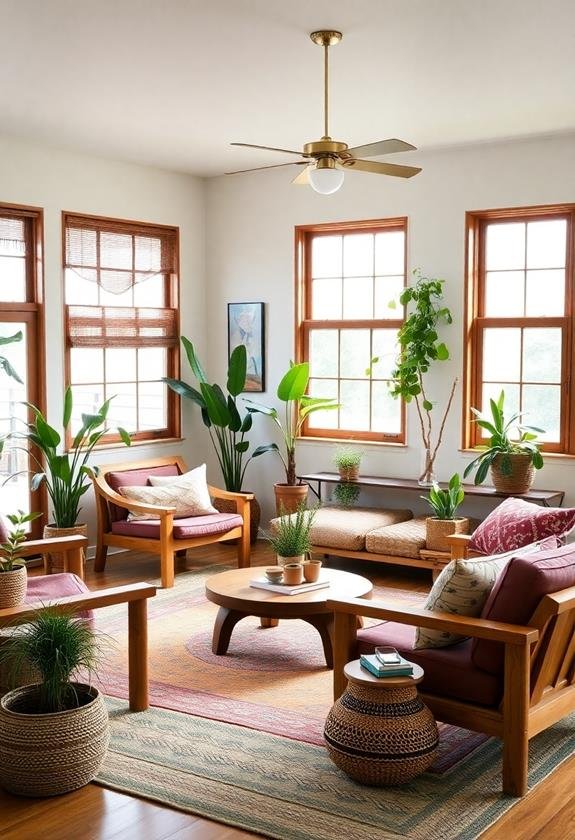
Integrating smart home technology not only enhances energy efficiency but also paves the way for another sustainable decor trend: local sourcing practices. By choosing to source materials and products from local artisans and suppliers, you can greatly reduce your carbon footprint and support your community. This approach brings uniqueness to your space while emphasizing sustainability.
Here are four key benefits of local sourcing practices:
- Reduced Transportation Emissions: By purchasing locally, you minimize the distance goods travel, leading to lower greenhouse gas emissions associated with transportation.
- Support for Local Economy: When you buy from local businesses, you're investing in your community, helping to create jobs and promote economic growth.
- Unique and Authentic Products: Local artisans often craft one-of-a-kind pieces, adding character and individuality to your decor that mass-produced items lack.
- Stronger Community Connections: Engaging with local suppliers helps foster relationships, allowing you to learn about the materials and the stories behind them, deepening your connection to your home.
Embracing local sourcing practices not only enhances your decor but also contributes to a more sustainable future.
Sustainable Color Palettes
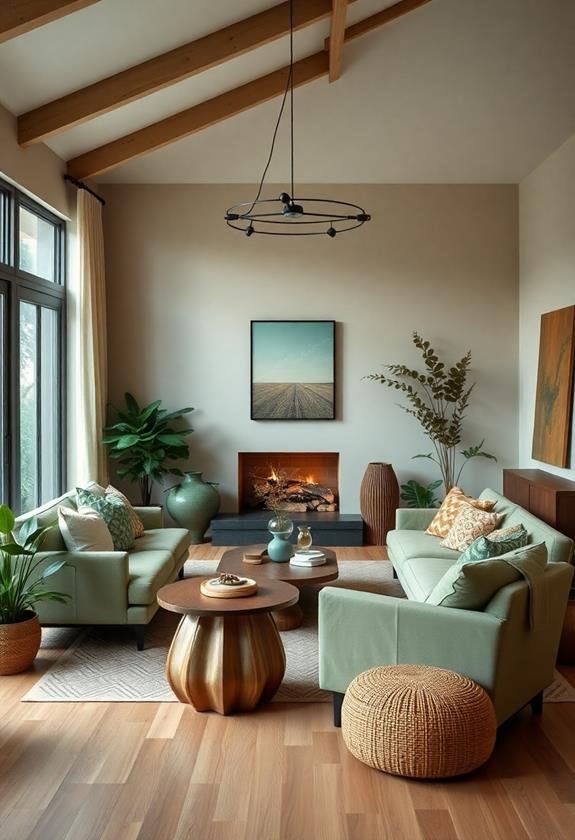
Your home's color palette can greatly impact its overall vibe and sustainability. When choosing colors, consider using eco-friendly paints made from natural materials, which not only minimize harmful emissions but also contribute to a healthier indoor environment. Earthy tones, such as soft greens, muted browns, and gentle blues, evoke a connection to nature, promoting serenity and comfort in your space.
Selecting colors inspired by your surroundings can help you create a harmonious atmosphere. For instance, if you live near the ocean, shades of aqua and sandy beige can bring a revitalizing coastal vibe indoors. Additionally, many sustainable brands now offer low-VOC (volatile organic compounds) paints that come in a range of beautiful colors, allowing you to maintain both style and sustainability.
To enhance your palette, you might also incorporate natural textiles and materials that complement your chosen hues. Think about using organic cotton curtains in soft pastels or jute rugs in warm neutrals. By thoughtfully selecting a sustainable color palette, you not only elevate your home's aesthetic but also contribute to a more environmentally friendly lifestyle. Embrace these choices, and your space will reflect both beauty and consciousness.
Frequently Asked Questions
What Are the Benefits of Sustainable Decor for Mental Health?
You might think that decor's just about aesthetics, but sustainable decor actually boosts your mental health. Surrounding yourself with eco-friendly materials can create a calming environment, reducing stress and promoting well-being. Natural elements, like plants, not only beautify your space but also improve air quality. Plus, knowing your choices support the planet fosters a sense of purpose and connection, which can elevate your mood and enhance your creativity. Embrace sustainable decor; your mind will thank you!
How Can I Incorporate Sustainability Into My Existing Decor?
To incorporate sustainability into your existing decor, start by repurposing items you already own, like turning an old ladder into a bookshelf. You can also choose eco-friendly materials, such as bamboo or reclaimed wood, for any new additions. Consider adding plants, which not only enhance aesthetics but also improve air quality. Finally, shop second-hand for unique pieces, reducing waste while giving your space a fresh look. Every small change makes a difference!
Are There Certifications for Sustainable Decor Products?
Yes, there are certifications for sustainable decor products. Look for labels like Forest Stewardship Council (FSC), which verifies wood comes from responsibly managed forests, or Global Organic Textile Standard (GOTS), which guarantees organic fabrics. These certifications help you make informed choices while shopping, confirming your decor aligns with eco-friendly principles. By choosing certified products, you're supporting sustainable practices and promoting a healthier environment, all while enhancing the beauty of your living space.
What Is the Cost Comparison Between Sustainable and Traditional Decor?
When comparing costs, sustainable decor often appears pricier upfront due to eco-friendly materials and ethical production practices. However, consider the long-term savings; these products usually last longer, requiring less frequent replacement. For example, a well-crafted sustainable piece might cost more initially, but its durability means you won't have to buy a replacement anytime soon. Ultimately, investing in sustainable decor can save you money while promoting environmental responsibility, making it a smart choice.
How Can I Educate Others About Sustainable Decor Trends?
To educate others about sustainable decor trends, start by sharing information through social media or community workshops. You could create engaging presentations that showcase the benefits of eco-friendly materials, like bamboo or recycled glass. Encourage discussions about the importance of reducing waste and conserving resources. Consider organizing a local event where people can swap decor items, fostering a community spirit. By sharing your knowledge and passion, you'll inspire others to embrace sustainable practices.

